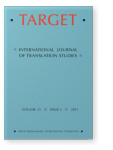Vol. 23:2 (2011) ► pp.272–310
Metaphern als Ausdruck subjektiver Theorien zum Übersetzen
Eine empirische Untersuchung zur konzeptuellstrukturierenden Funktion von Metaphernmodellen bei Studienanfängern [1] 1
In this article we introduce a model for and an empirical study of the role of metaphors in the construction and application of subjective or implicit theories by novice translators. Our goals are to analyze the structure of the subjective knowledge of translators and to determine their role in the process of translation, but also to develop a specific research method. From a theoretical point of view the study is based on our model of the nature, the function and the acquisition of subjective theories of translation. The analysis of metaphors is based on conceptual metaphor theory and on empirical research on metaphor in applied linguistics. Both the model and the research method have proved to be useful for the investigation of implicit theories about translation.
Article outline
- 1.Einleitung
- 2.Implizite Theorien in der translationswissenschaftlichen Forschung
- 2.1Der soziologische Ansatz: Normen, Memes
- 2.2Der kognitve Ansatz: Maximen, Regeln, Überzeugungen
- 3.Subjektive Theorien
- 3.1Begriffsbestimmung
- 3.1.1Funktion.
- 3.1.2Aufbau und Umstrukturierung.
- 3.1Begriffsbestimmung
- 4.Metaphern und Analogien als subjektive Theorien
- 5.Subjektive Theorien und Metaphern im Übersetzungsprozess
- 5.1Forschungsfragen
- 5.2Datenerhebung
- 5.3Metaphernanalyse
- 5.3.1Gemeinsame Metaphern.
- 5.3.1.1Die Transfer-Metapher.
- 5.3.1.2Die ÄNDERUNGS-Metapher.
- 5.3.2Idiosynkratische Metaphern
- 5.3.2.1Ein Übersetzer ist eine Steckdose.
- 5.3.2.2Eine Übersetzung ist ein Gemälde.
- 5.3.2.3Eine Übersetzung ist ein wachsender Baum.
- 5.3.2.4Eine Übersetzung ist ein chemisches Experiment.
- 5.3.1Gemeinsame Metaphern.
- 6.Schlussfolgerungen und Ausblick
- 6.1Inhalt der impliziten Theorien
- 6.2Metaphernverbindungen
- 6.3Funktion der Metaphern
- 6.4Erwerb und Entwicklung des in den Metaphern strukturierten Wissens
- 6.5Angemessenheit der metaphorischen Modelle
- 6.6Forschungsmethode
- 6.7Ausblick
- Notes
-
Bibliographie
Article language: German
